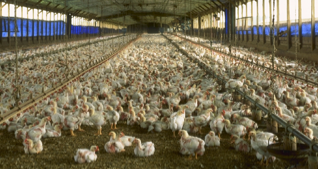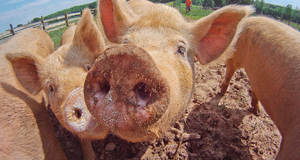From Earth Common Journal VOL. 3 NO. 1The Price of Development: The Importance of Preserving Local Agricultural Lands
IN THIS ARTICLE
AbstractRegardless of the fact that we have long been warned of the negative impact of industrial farming, rural communities are being wiped out as local producers, like Riverbend Gardens, are put at risk in favour of urban expansion. The industrial food production industry is unsustainable, leading to increased energy consumption and food costs because of the gross use of energy to transport food hundreds kilometres from where it is produced. Toxic chemicals used to combat swarms of pests that are nurtured by acres of single crop farming have lead to the increase of these substances in our environment. The growing disconnection between ourselves and how our food is produced, fostered by diminishing farm communities, allows us to continue as we always have, until our current system collapses. This will have a deleterious effect on our health and our environment. Many of the answers to the problems we face in our food production industry lies in support for our small, local food producers. Located within Edmonton city limits, sustainable, family run, Riverbend Gardens, is at risk of being wiped out if government and consumers do not recognize the importance of small producers and their part in solving the food industry’s failures. IntroductionNestled along the North Saskatchewan River, an old growth forest speckled with poplar and spruce presides over rows of vegetable plants that spring forth from the creased earth. There is something captivating about Riverbend Gardens. It may be the magic of an agricultural oasis in the boundaries of the Edmonton metropolis. Maybe it is the microclimate, created by the natural landscape, which supports perfect growing conditions (Messenger, 2013, para. 2-4). Or perhaps, it is that local producers like Riverbend Gardens “. . . are the essence of sustainability. . . . [They show us] it is possible for humans to feed themselves over a period of thousands of years, without exhausting the natural resources around them” (Elton, 2013, p. 255).
Whatever the magic is at Riverbend Gardens, this and other small, sustainable food producers are under the threat of being overlooked and steam-rolled by urban expansion over local business or the environment. It is important that we as a society recognize local producers as connected to the community, to the earth, and to part of the solution needed for reducing the impact the current food production industry has on our health and the environment. Unsustainable Energy Consumption and Increasing CostsFarming, which originally resembled small-scale producers like Riverbend Gardens, has attributed to the shape of contemporary society, and as noted by Dick and Taylor (2012), has enabled people to live in progressively larger groups (para. 1). But, as societies grew so grew the need to produce enough food to feed all the people within them (para. 1). This prompted the industrialization of agriculture and what has become an unsustainable food production industry. And we have long been aware that industrialized farming and much of our food production industry is unsustainable, unable to continue at the same rate or level. A recent study commissioned by the UN found that “agriculture and food consumption are ‘one of the most important drivers of environmental pressures’” (Notras, 2010, para. 11). The World Watch Institute, which analyzes interdisciplinary environmental data worldwide to provide information for building a sustainable society, suggests that, “transporting food is one of the fastest-growing sources of greenhouse gas emissions” (Centre for Environmental Education, 2008, para. 1). This is a result of the “817 million tons of food . . . shipped around the planet” (para. 1) each year, because “a basic diet of imported products can use four times the energy and produce four times the emissions of an equivalent domestic diet” (para. 1). In response to this information, people are being encouraged to buy locally produced food to reduce the energy used, often unnecessarily, in food transportation. However, if local growers continue to lose out to urban sprawl, there will be no local producers left to buy from. Unsustainable Exposure to Toxic ChemicalsHowever, the UN is not the first to warn us of the negatives related to industrial agriculture. Rachel Carson warned in her book, Silent Spring, published in 1962, that “single-crop farming does not take advantage of the principles by which nature works; it is agriculture as an engineer might conceive it to be” as (p. 10). As such, this has lead to an increased need for pest control, which has a deleterious affect on both the environment and human health (Watts, 2008, para. 1). In comparison, “under primitive agricultural conditions the farmer had few insect problems. These arose with the intensification of agriculture — the devotion of immense acreages to a single crop. Such a system set the stage for explosive increases in specific insect populations” (Carson, 1962, p.10). Rachel Carson (1962) also warned against the use of chemicals for pest control, like methyl parathion, which is “among the most poisonous chemicals in the world” (p. 27). The United States Environmental Protection Agency (1999) found that methyl parathion could not meet dosage requirements to be consumed safely over a seventy-year lifetime (para. 2). Yet, it was still “one of the most toxic and most widely used organophosphate pesticides” (para. 1), even though, according to Dr. Watts, there is a continuous, worldwide proposal to ban the deadly chemical (para. 3). This is especially concerning. According to the report “Pesticides and Chemicals that Impact Agriculture”(n.d.), many pesticides are resistant to degradation, which translates to persistence in both the environment and in living things (p. 3). These chemicals don’t remain where they are sprayed. Instead, they leak into “forests, rangeland, aquatic habitats” (Witford, Miller, Bennett, Jones, & Bledsoe, n.d., para. 10), contaminating “ground water, surface water, rain, snow, fog, soil, vegetation and crops” (“Pesticides and Chemicals,” n.d., p. 3). Thus, pesticides have become ubiquitous in the environment, exposing wildlife to toxic chemicals. According to Witford et. al, (n.d.) “acute poisoning to wildlife takes place over a relatively short time, impacts a very localized geographical area, and is linked to a single pesticide” (para. 11). Another negative affect of pest control is that it kills bees with as little discrimination as pest insects, which has disastrous implications for our future as “bees are credited with approximately 85 percent of the pollinating activity necessary to supply about one-third of the nation's food supply” (Stanford, 2013, para. 1). In general, it is “worker bees are those primarily affected by pesticides” (Stanford, 2013, para. 5). And although worker bees are on the front lines, they are not the only bees put at risk of being poisoned by pesticides: “some kill bees on contact in the field; others may cause brood damage or contaminate pollen, thus killing house bees” (para. 10). Researchers estimate that “nearly one-third of all honey bee colonies in the country have vanished” (Natural Resources Defense Council [NRDC], 2012, para. 3), and the suggested cause is a combination of issues, one of which is exposure to toxic pesticides (para. 4). Bees are necessary for agricultural and environmental processes to operate properly, and “the list of crops that simply won’t grow without honeybees is a long one: Apples, cucumbers, broccoli, onions, pumpkins, carrots, avocados, almonds … and it goes on” (para. 1). Recognizing the potential dangers to human health and the environment, the growers at Riverbend Gardens “take great care with our farming methods. We are responsible and cautious in our treatment of the land . . . . using specific conventional treatments minimally and cautiously.” (Riverbend Gardens, 2013, para. 5, 7).Continued on Next Page » Suggested Reading from Inquiries Journal
Inquiries Journal provides undergraduate and graduate students around the world a platform for the wide dissemination of academic work over a range of core disciplines. Representing the work of students from hundreds of institutions around the globe, Inquiries Journal's large database of academic articles is completely free. Learn more | Blog | Submit Latest in Environmental Studies |




















